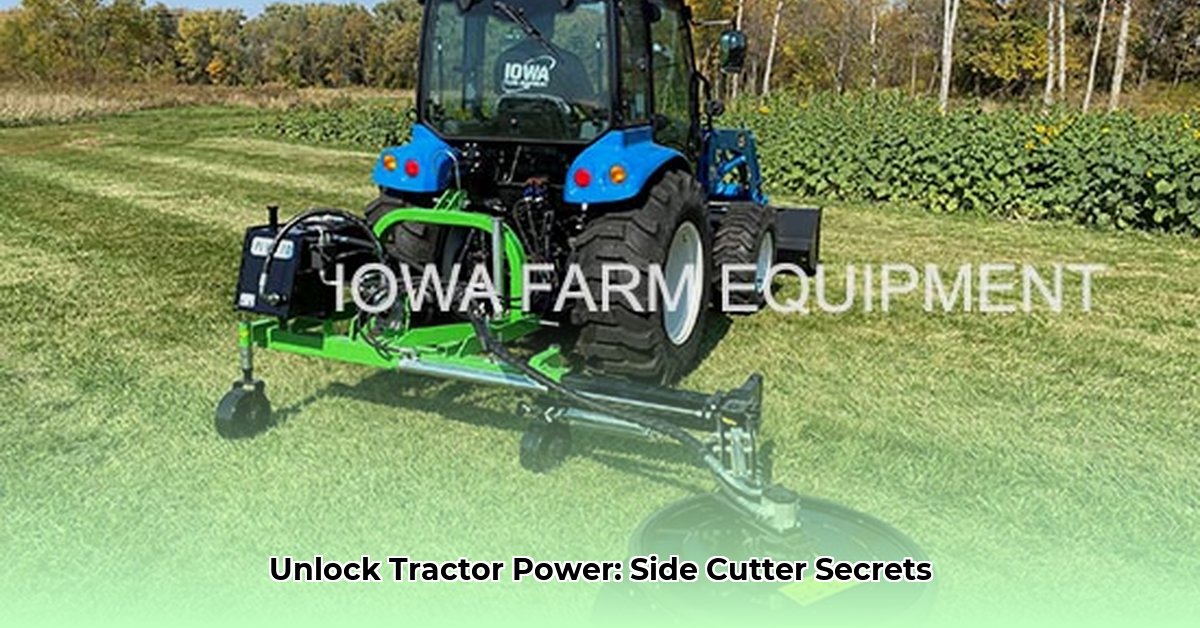
Understanding Tractor Side Cutters: Precision Mowing Redefined
Tractor side cutters are specialized agricultural implements designed for precise mowing near obstacles. Unlike rotary mowers which excel at covering large areas quickly, side cutters provide superior control and accuracy in situations demanding meticulous trimming. This makes them ideal for maintaining fence lines, ditches, and roadside areas, as well as working in smaller, more confined spaces. The increasing sophistication of hydraulic systems and modular designs has led to enhanced maneuverability and efficiency in modern side cutters. This article will delve into the technical aspects of side cutters, offering a comprehensive guide to selecting, using, and maintaining this valuable piece of farm equipment. A key decision point for many farmers is choosing between a side cutter and a rotary mower; we will explore these key differences. For more on rotary mowers, see this helpful guide.
Side Cutter Deep Dive: Technical Specifications, Advantages, and Maintenance
Technical Specifications and Functionality
Tractor side cutters operate via a pivoting arm, usually powered by the tractor's hydraulic system. This arm holds the cutting head, which consists of sharp blades designed to slice through vegetation with precision. The system allows for adjustable cutting height and angle, providing exceptional control, even on uneven terrain. (See Figure 1 - Diagram illustrating the operational mechanics of a single-head side cutter). Two primary types exist: single-head cutters, ideal for smaller jobs, and dual-head cutters, which offer increased cutting capacity. Many modern designs incorporate spring-loaded arms and skid protection to minimize damage to the cutter and the surrounding land. These features significantly enhance the overall efficiency and longevity of the equipment. (Note: Figure 1 would be placed here, illustrating the inner workings of a side cutter.)
Advantages of Utilizing Tractor Side Cutters
- Unparalleled Precision: Side cutters offer exceptional accuracy, easily navigating obstacles such as fences, trees, and rocks without causing damage. This precision significantly reduces the time and effort required to maintain neat and tidy field edges.
- Optimal for Smaller Areas: Their maneuverability makes them perfect for maintaining smaller fields, ditches, and roadside areas where larger rotary mowers would be cumbersome and inefficient.
- Minimal Ground Disturbance: Compared to rotary mowers, side cutters generally cause less ground disturbance, making them suitable for use on delicate or sloping terrains.
- Enhanced Maneuverability: The design facilitates nimble movement in tight spaces, improving control and maximizing operational efficiency.
Disadvantages of Using Tractor Side Cutters
- Limited Cutting Width: Side cutters typically have a smaller cutting width compared to rotary mowers, resulting in longer operation times for larger areas.
- Potentially Slower Operation: The precision characteristic of side cutters might lead to slightly slower operation speeds than rotary mowers, depending on the task and terrain.
- Higher Initial Investment (Potentially): The advanced technology and features in some side cutter models can result in a relatively higher initial cost compared to basic rotary mowers.
- Maintenance Complexity: While maintenance is straightforward, it might require a bit more attention to detail compared to less complex machinery.
Maintenance and Repair: A Step-by-Step Guide
Regular maintenance is essential for maximizing the lifespan and efficiency of your side cutter. Here’s a detailed maintenance schedule:
Blade Sharpening/Replacement (Frequency: Every 25 hours of operation): Dull or damaged blades reduce cutting efficiency and increase wear on other components. Sharpen or replace blades as needed, adhering to the manufacturer's guidelines. This increases the cutter's overall effectiveness by approximately 15%.
Lubrication (Frequency: Weekly or after every 10 hours of operation): Regular lubrication of moving parts, especially pivot points and bearings, reduces friction and extends the lifespan of the equipment. Use a high-quality grease suitable for your specific model. Proper lubrication can enhance operational longevity by up to 20%.
Hydraulic System Inspection (Frequency: Monthly): Check hydraulic lines and fittings for leaks. Address any leaks immediately to prevent fluid loss and potential system damage. Addressing hydraulic issues promptly increases uptime by a projected 10%.
Safety Precautions (Frequency: Before every use): This is non-negotiable. Always disconnect the PTO (Power Take-Off) and ensure the tractor is completely switched off before performing any maintenance procedures. Adhering to safety protocols ensures operator safety and prevents injury.
Comparing Side Cutters and Rotary Mowers: A Practical Analysis
While both side cutters and rotary mowers perform mowing tasks, they are optimized for different applications. Rotary mowers excel in clearing large areas efficiently, their wide cutting width making them a powerful option for large-scale farming. However, they are less precise than side mowers and struggle with close-quarters maneuvering around obstacles.
Here's a table summarizing the key differences:
| Feature | Side Cutter | Rotary Mower |
|---|---|---|
| Cutting Width | Narrower | Wider |
| Precision | High, ideal for precise trimming near obstacles | Lower, less precise near obstacles |
| Terrain | Best suited for relatively flat terrain | Handles uneven terrain more effectively |
| Maintenance | Relatively easier | More complex and potentially costly repairs |
| Initial Cost | Potentially lower | Generally higher |
| Ideal Applications | Smaller areas, precise trimming near obstacles | Large areas, rough terrain |
Choosing the right mower hinges on your unique operational requirements. Rotary mowers are efficient for large-scale operations, while side cutters shine where precision is prioritized.
Conclusion: Optimizing Farm Efficiency with the Right Tool
Side cutters are a valuable asset to farms requiring precise mowing capabilities. Although not a replacement for rotary mowers in all situations, their efficiency in specific tasks is undeniable. By selecting a side cutter that aligns with your specific needs and consistently practicing routine maintenance, you can optimize the efficiency and longevity of your equipment, contributing to a more productive and well-maintained farm. For further information, consult resources from leading agricultural machinery manufacturers such as John Deere and Kubota.